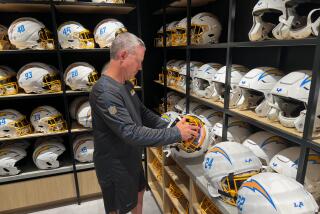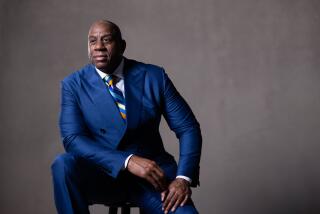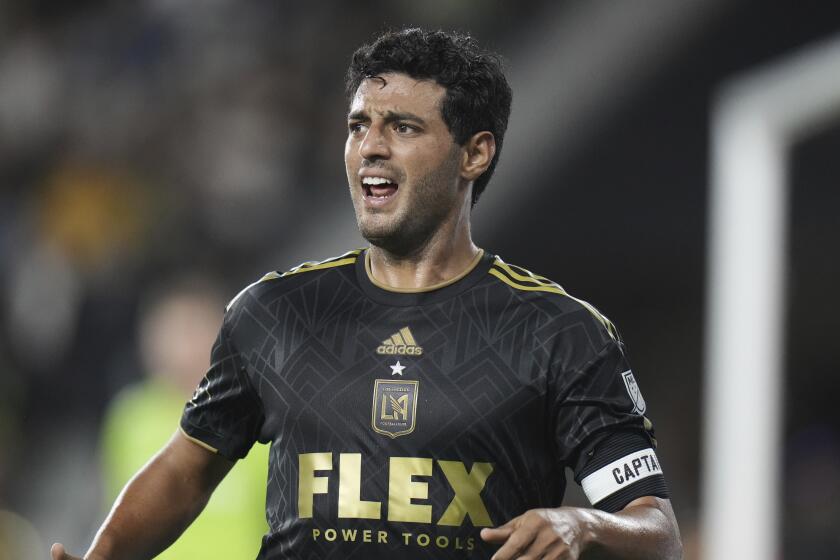He Directs the Family Business
- Share via
INDIANAPOLIS — When you’re the general manager of a professional football team, you might have to work for an owner who is a woman, a corporation, a general partner, even a town.
Or, if you’re Jim Irsay, you might have to work for someone who is harder to please than any of them--your father.
The Indianapolis Colts aren’t so much a team as a migration. Their genealogy is harder to trace than the Hopi Indians’. Their origins are as obscure as an international spy’s.
They died twice. As the Baltimore Colts. They have had more reincarnations than Shirley MacLaine.
The present Colts began life as the Boston Yanks in the old, now defunct, All-America Conference, owned by Kate Smith, no less, America’s Songbird.
Kate moved the team to New York, where they became the New York Yanks and, later, the New York Bulldogs. Franchises could be moved in those days without someone making a federal case out of it.
Then, they became the Dallas Texans, a rag-tag team of nomadic nobodies who would play wherever they could collect a crowd or pass the hat.
Dallas didn’t want them and the team became the Baltimore Colts when the NFL commissioner informed a committee of Baltimoreans they could have it if they could sell 16,000 tickets to see them play.
Some people would have thought Baltimore would buy tickets to see this gypsy band move on, but a shrewd local entrepreneur named Carroll Rosenbloom collected the obligatory pledges. For a little over 50 grand, he had gotten himself an NFL team. Carroll knew that when you had something there were only 12 of in the world, you were beating the price.
The original Baltimore Colts had gone belly-up only three years before. Another bankrupt All-America Conference team, the Miami Seahawks had been dumped on Baltimore’s doorstep. Baltimore kicked them off.
But the Baltimore Colts, the sequel, shortly got John Unitas and, in no time at all, they became one of the most successful franchises in the grand game.
But when Unitas got old, the team got frayed around the edges. Rosenbloom figured out a novel way to get rid of them.
It’s hard to believe now that Robert Irsay traded the Los Angeles Rams for this over-the-edge band but, in a kind of complicated tax dodge, Rosenbloom steered him through an exchange maze that left Rosenbloom with Hollywood’s favorite team and Irsay with a team quarterbacked by Bert Jones.
Irsay hung in there but, in 1983, when John Elway announced he would rather stay in baseball in Oneonta, N.Y., than quarterback the Baltimore Colts, Irsay got the message and began to cast around for a place to go.
Any direction would do, including, presumably, straight up or down but he settled on Indianapolis. They had a new domed stadium, a nice smile and the customary municipal bag of tax and rental goodies.
It is one of the malaises of the 20th Century that sons of successful fathers seldom move into the family business. Garment manufacturers can’t get the kids down on Seventh Avenue, ministers’ children run away to join the circus or communes. Bankers’ sons have no head for figures. The chips fall where they may.
But Robert Irsay’s son was more than a chip off the old block. He was a born jock. He was even a pug who’d had some blood baths in the clubs around South Chicago. But as soon as he figured no one was going to put “Sugar” in front of his name, Jim Irsay turned to football. He was a walk-on at SMU after a career as a linebacker and tight end at prep school. He lifted weights, played par golf and dabbled in shotputting.
Bob Irsay had taken the Colts out of town by fire escape, so to speak, spiriting them away in the dead of night. They were kind of the Devil’s Island of pro football.
They lacked a lot of things in those days but chiefly they lacked a lively general manager. No one figured father Bob was doing son Jim any especial favor when he gave him the job.
The usual policy of a father with a son learning the business would be to have him start at the bottom--say, picking up the towels after the team practice, getting the coffee, manning the switchboard.
Jim Irsay did his share of the Hey-you! jobs but he also was a student of the game.
He perceived at once that the main thing the Colts lacked was identity. The main problem facing them was anonymity. They might as well have been playing in full masks and under assumed names.
“We were bigger secrets than jewel thieves,” recalls Jim Irsay. “We hadn’t been on ‘Monday Night Football’ in 10 years. We were the team that Elway snubbed. We had no real identity. Not only didn’t the league know who we were, we didn’t know who we were.”
If Papa Irsay expected his youngest son to become a decorative, Yes Pop, don’t-make-waves GM, young Jim roused him out of his expectations when he pulled one of the daring raids in pro football history. He brought instant recognition and respect to the Indianapolis Colts when he put together a three-way package among the Rams, Buffalo Bills and Colts that resulted in the procurement of the most celebrated running back of the age, Eric Dickerson, for the Colts. It was like getting Paul Newman for your movie.
They made “Monday Night Football,” all right. They came close to making the Super Bowl.
The deal was daring but not reckless. Basically, the Colts gave up a very good player, Cornelius Bennett. But he was a player the Colts didn’t have. They had drafted him, they couldn’t sign him. Buffalo lusted for him.
The Rams didn’t want real people. They were betting on the come--draft choices. Between them, Buffalo and Indianapolis could come up with the requisite number of draft choices.
So the Bills got whet they wanted, Bennett; the Colts got what they wanted, their name on the marquee, and the Rams got what they wanted, rid of Dickerson.
Dickerson didn’t put the Colts in the Super Bowl. But he put them back in the league. They were no longer football’s largest permanent, established, floating crap game. Attention was paid.
This year, young Irsay made an even bolder reach. He traded off real all-pro people, like Andre Rison and Chris Hinton, to get a University of Illinois quarterback, Jeff George.
No one knows whether Jeff George will become another Unitas or even another Elway but Jim Irsay feels the gamble must be taken.
“You have to have stability at quarterback,” he says. “For years, we’ve been drafting for need. That’s the biggest fumble in football. What do you say, ‘Well, I think I will leave Joe Montana there and pick a cornerback because we need cornerbacks and we already have quarterbacks?’ You don’t draft for need, you draft for ability. We were drafting for need and finishing dead last in the conference--3-13 in 1986. We got Dickerson, we finished first the next year.”
Jim Irsay is not the first executive to say, “Thanks, Dad” for his opportunity. But it is not a doting father-son relationship.
“Sometimes, you can hear the arguments clear over in the next county,” admits the young Irsay.
Most scions, when they take over the family business, can be measured in accounts receivable, net-before-taxes, expansion in the market. Young Jim Irsay gets measured by touchdowns, yards, divisional and conference play.
Irsay believes in a front office that will go long, too. If you don’t throw the bomb occasionally from the executive suite, you’re not going to throw it from the pocket. The family business suits Jim Irsay just fine. Even with his father looking over his shoulder and saying, “What in the world are we doing this for, boy?”
More to Read
Go beyond the scoreboard
Get the latest on L.A.'s teams in the daily Sports Report newsletter.
You may occasionally receive promotional content from the Los Angeles Times.










